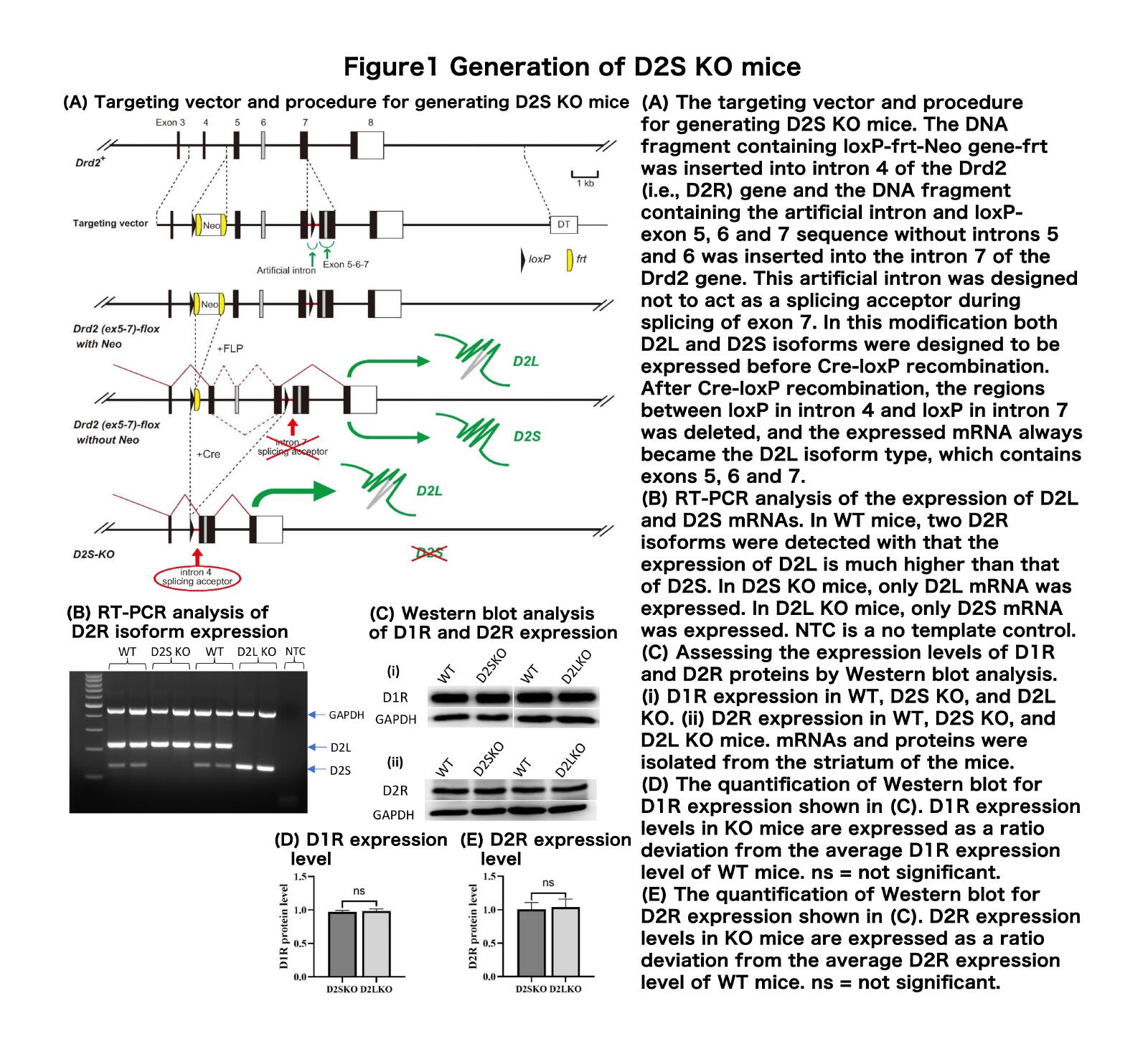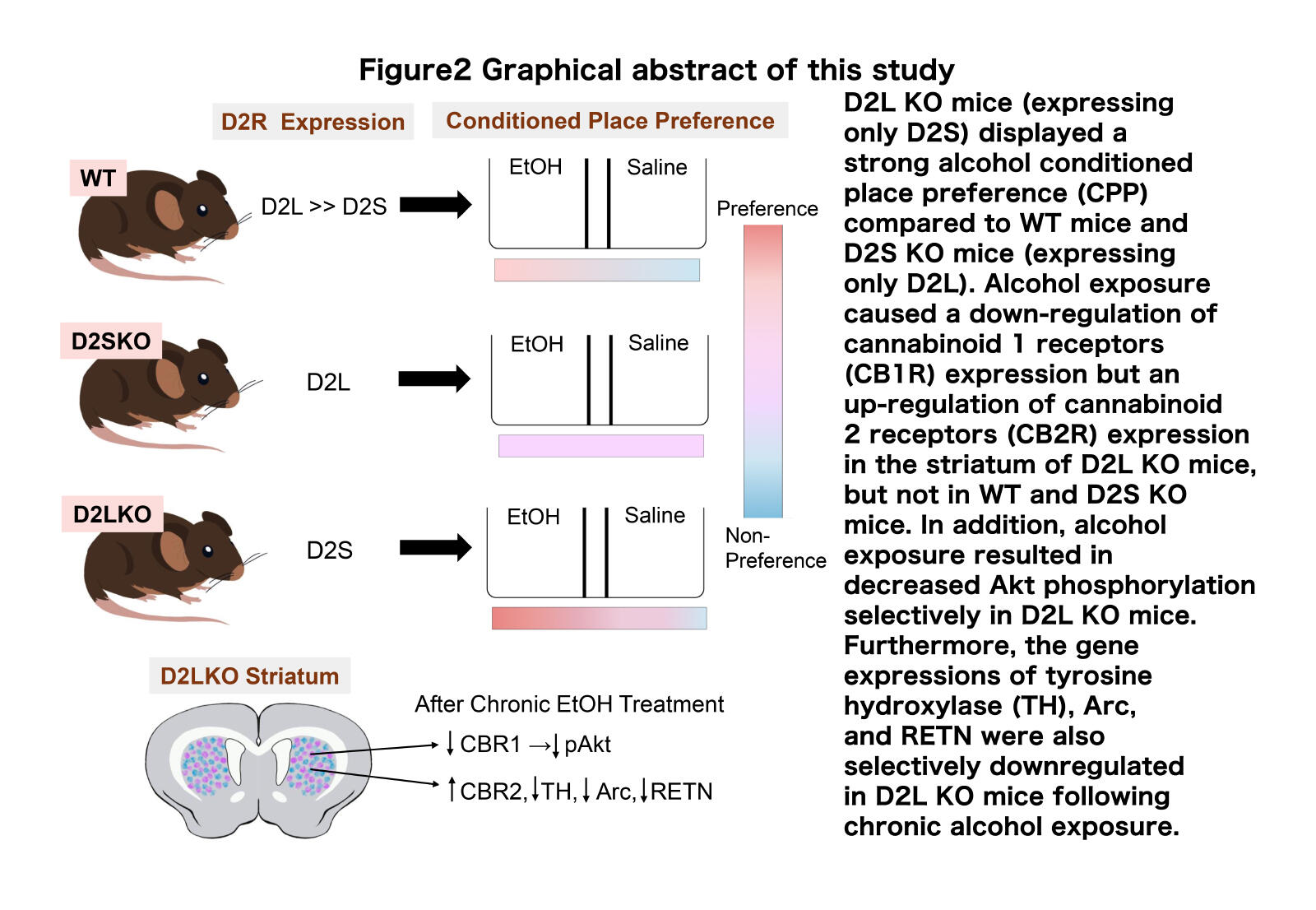2025.11.17
Dopamine D2S/D2L Receptor Regulation of Alcohol-Induced Reward and Signaling
Article explaining the research
Authors: Mohd Tayyab, Toshikuni Sasaoka, Manabu Abe, Nae Saito, Kenji Sakimura, Anetta Ninan, YanYan Wang*
Title: Dopamine D2S/D2L Receptor Regulation of Alcohol-Induced Reward and Signaling
Journal: Addiction Biology
doi: https://doi.org/10.1111/adb.70093
1. Summary of the Study
Collaborative research groups including Associate Professor YanYan Wang, Dr. Mohd Tayyab, and Dr. Anetta Ninan from the University of Texas at Tyler, and Professor Toshikuni Sasaoka, Technical Staff Member Nae Saito (then), Associate Professor Manabu Abe, and Professor Emeritus Kenji Sakimura at Niigata University conducted research to investigate the role of dopamine D2 receptor (D2R) isoforms in alcohol use disorder. The research aimed to examine whether differential expression of D2R isoforms affects the reinforcing effects of alcohol and its associated molecular signaling. Through collaboration between the University of Texas at Tyler and Niigata University, the team generated novel D2S knockout (KO) mice―expressing only the D2L isoform―using Cre-loxP-based gene editing (Figure 1), complementing existing D2L KO mice that express only the D2S isoform (Figure 1). Behavioral assays, including conditioned place preference (CPP), open-field, elevated zero-maze, and rotarod tests, were conducted along with chronic alcohol exposure to evaluate motor coordination and reward sensitivity. Molecular and biochemical analyses (RT-PCR, qPCR, Western blotting) of striatal tissue were subsequently performed to assess changes in cannabinoid receptor expression, Akt signaling, and dopaminergic and synaptic plasticity-related genes. The key findings were that D2L KO mice, with elevated D2S expression, displayed strong alcohol-induced CPP and downregulation of cannabinoid type 1 receptors (CB1R), phosphorylation of Akt (p-Akt), tyrosine hydroxylase (TH), activity-regulated cytoskeleton-associated protein (Arc), and resistin (RETN), but upregulation of cannabinoid type 2 receptors (CB2R), and these changes were absent in WT and D2S KO mice (Figure 2). These results demonstrate that the relative abundance of D2S to D2L critically modulates alcohol reward and its associated signaling, providing molecular insight into the neurobiological basis of alcoholism.


2. Main Points of the Research Findings
This study elucidates the distinct roles of the two dopamine D2 receptor (D2R) isoforms―D2 long (D2L) and D2 short (D2S)―in alcohol-induced reward and neural signaling. Using genetically engineered knockout (KO) mice that selectively express either D2L or D2S, the researchers found that D2L KO mice, which express only D2S (Figure 1B), exhibited a pronounced conditioned place preference (CPP) to alcohol, whereas wild-type (WT) and D2S KO mice, which express only D2L (Figure 1) did not. Chronic alcohol exposure in D2L KO mice led to downregulation of cannabinoid type 1 receptors (CB1R), upregulation of cannabinoid type 2 receptors (CB2R), and reduced phosphorylation of Akt in the striatum (Figure 2). Additionally, alcohol exposure specifically reduced the expression of tyrosine hydroxylase (TH), activity-regulated cytoskeleton-associated protein (Arc), and resistin (RETN) genes in D2L KO mice (Figure 2). These results indicate that an increased D2S/D2L ratio profoundly influences alcohol reward behavior and striatal gene regulation, likely through the cannabinoid-Akt signaling cascade. The findings suggest that if altered splicing of the D2R gene results in higher D2S expression relative to D2L, it may lead to susceptibility to alcohol use disorder (AUD) by enhancing alcohol-induced reward signaling.
3. Background of the Research
Alcohol use disorder (AUD) remains a major global health issue, which has been shown to be closely linked to alterations in the dopaminergic reward system. Dopamine D2 receptors (D2R) play a pivotal role in mediating motivation, reward, and addiction vulnerability. Neuroimaging studies have shown that chronic alcohol consumption leads to reduced D2R availability/function and altered dopaminergic signaling in the striatum, but the specific molecular mechanisms remain poorly defined. The D2R gene undergoes alternative splicing to produce two functionally distinct isoforms: D2L and D2S. These isoforms differ in their cellular localization and signaling properties, suggesting potential differential roles in addiction-related processes. Moreover, D2R signaling interacts closely with the endocannabinoid system (CB1R and CB2R) and the Akt kinase pathway, both implicated in reward modulation and alcohol-induced neuroadaptations. Given this intricate cross-talk, the researchers hypothesized that the balance between D2S and D2L expression could determine individual responses to alcohol and the risk of developing addiction. The study therefore sought to elucidate how the expression ratio of these isoforms affects behavioral and molecular outcomes following alcohol exposure, providing new insights into D2R splicing as a possible mechanism underlying AUD susceptibility.
4. Research Outcomes
The study revealed that D2S and D2L isoforms exert distinct influences on alcohol-induced behavior and signaling. D2L KO mice, expressing only D2S, exhibited enhanced alcohol reward, as measured by CPP, whereas D2S KO and WT mice showed no significant preference. In D2L KO mice, chronic alcohol treatment caused selective downregulation of CB1R, upregulation of CB2R, and decreased Akt phosphorylation, indicating disruption of the cannabinoid-Akt signaling axis. Furthermore, key genes involved in dopamine synthesis (TH), synaptic plasticity (Arc), and addiction-related signaling (RETN) were significantly downregulated only in D2L KO mice. Motor coordination was also more impaired in D2L KO mice after alcohol exposure, suggesting a unique role of D2L in motor control. Collectively, these findings support a model in which elevated D2S expression relative to D2L promotes alcohol-induced reinforcement and alters molecular pathways associated with dopamine-cannabinoid cross-talk. This differential isoform function highlights the importance of D2R splicing regulation in shaping vulnerability to alcohol addiction.
5. Future Perspectives
This study provides compelling evidence that altered D2R splicing and the resulting D2S/D2L imbalance contribute to the neurobiological mechanisms of alcohol reinforcement and dependence. Future research should explore whether similar mechanisms operate in other substance use disorders, such as those involving opioids or psychostimulants. Investigating the regulatory mechanisms controlling D2R splicing could uncover novel therapeutic targets aimed at restoring optimal D2S/D2L expression balance. Pharmacological interventions that modulate D2R isoform expression or normalize cannabinoid-Akt signaling may hold promise in preventing or treating AUD. Additionally, translational studies in humans examining D2R splicing variants and CB1R/CB2R polymorphisms could identify biomarkers predictive of addiction vulnerability. By linking genetic regulation, receptor signaling, and behavioral outcomes, these findings pave the way for precision medicine approaches in addiction neuroscience, offering new strategies for early detection and personalized treatment of alcohol use disorder.
6. Original publication
Dopamine D2S/D2L Receptor Regulation of Alcohol-Induced Reward and Signalling.
Mohd Tab, Toshikuni Sasaoka, Manabu Abe, Nae Saito, Kenji Sakimura, Anetta Ninan, YanYan Wang
Addiction Biology, 15 November, 2025
▸ https://doi.org/10.1111/adb.70093
7. Glossary
① Dopamine D2 Receptor; D2R
The dopamine D2 receptor (D2R) is a key receptor in the brain that binds the neurotransmitter dopamine and regulates reward, motivation, and motor control. The D2R gene produces two splice variants: the long form (D2L) and the short form (D2S). These isoforms differ in cellular localization and signaling functions, influencing susceptibility to addiction and other neuropsychiatric disorders.
② Isoform
An isoform is a protein variant derived from the same gene through processes such as alternative splicing. In the case of the dopamine D2 receptor, the D2L and D2S isoforms differ in structure and function, contributing to distinct roles in neural signaling and behavior.
③ Conditioned Place Preference; CPP
Conditioned Place Preference (CPP) is a behavioral test used to measure the rewarding effects of substances. Animals learn to associate a specific environment with a pleasurable stimulus (e.g., alcohol or drugs), and their preference for that environment reflects the substance's reinforcing value.
④ Cannabinoid Receptors; CB1R and CB2R
Cannabinoid receptors are part of the endocannabinoid system that regulates neural and immune functions. CB1R is predominantly expressed in neurons, while CB2R is mainly found in immune and glial cells. These receptors interact with the dopamine system and modulate reward, emotion, and addiction-related behaviors.
⑤ Akt Phosphorylation
Akt, also known as protein kinase B, is an intracellular signaling enzyme activated through phosphorylation. It regulates synaptic plasticity, cell survival, and reward learning. Alterations in Akt phosphorylation are associated with alcohol and dopamine receptor signaling changes in the brain.
⑥ Tyrosine Hydroxylase; TH
Tyrosine hydroxylase (TH) is the rate-limiting enzyme in dopamine synthesis, catalyzing the conversion of tyrosine to L-DOPA. Its expression is influenced by chronic exposure to alcohol or drugs, thereby regulating dopamine production and neural signaling.
⑦ Activity-Regulated Cytoskeleton-Associated Protein; Arc
Arc (Activity-Regulated Cytoskeleton-Associated Protein) is an immediate-early gene involved in synaptic plasticity and memory formation. Its expression is activity-dependent and modulated by addictive substances, linking it to reinforcement learning and addiction.
⑧ Dopamine Reward System
The dopamine reward system comprises brain regions such as the striatum and ventral tegmental area (VTA) that regulate pleasure, motivation, and learning. Alcohol and other addictive substances increase dopamine release in this system, reinforcing reward-related behaviors and promoting addiction.





